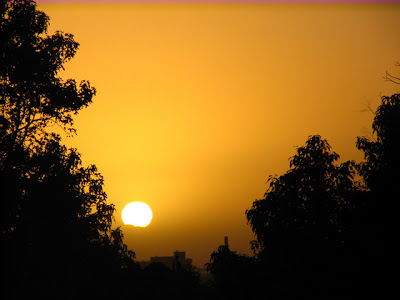 |
| Montezuma Castle National Monument, Arizona |
During my 2012 visit to the United States, I spent five nights in
Flagstaff, Arizona, which I used as my base while I explored some of the
surrounding country. During my stay, one of the locations I happened upon―as I
headed somewhat randomly, south―was the Montezuma Castle National Monument, a
short distance off Interstate 17. Phoenix is approximately 140 km (87 mi) south
of the monument, and Flagstaff, is about 80 km (50 mi) north.
I had never heard of the monument before my visit, nor
therefore, had I seen images of the site. To say I was awestruck by the size
and scale of what turns out to be some of the best preserved cliff-dwellings in
the American Southwest, is an understatement.
The cliff-dwellings at Montezuma Castle were built and used
by the Pre-Columbian Sinagua people around 700 AD. The Sinagua were northern
cousins of the Hohokam, and the site was occupied from approximately 1125 to
1400 AD, with peak occupation thought to be around 1300 AD. By the way, when
European Americans discovered the cliff-dwellings in the 1860s, they named them
for the Mexican Aztec emperor, Montezuma II, due to mistaken belief that the
emperor had been connected to their construction. In fact, neither part of the
monument's name is correct. The site was abandoned by the Sinagua 100 years
before Montezuma was born, and the dwellings were not a castle. The building
was more like a prehistoric high rise apartment complex.
Exactly why the Sinagua abandoned the cliff-dwellings is not
known, but warfare, drought, and clashes with the newly arrived Yavapai people
have been suggested. The five-story stone and mortar dwellings contain 20 rooms
and once housed about 50 people. Nearby are the remnants of Tuzigoot (Apache for
“Crooked Water”), a Singuan Village built on the summit of a ridge. Tuzigoot
was two stories high, with 77 ground floor rooms that were accessible via
ladders through roof openings. Unfortunately, little of this site has remained.
 |
| Montezuma Castle information panel |
Due to its isolated location, only about 350,000 tourists
visit the site each year. Access to the ruins themselves has not been allowed
since 1950 due to extensive damage of the dwelling, and the unstable nature of
the limestone cliff face. However, there is a paved trail that leads from the
visitor centre and skirts the base of the cliff containing the ruins, from
which excellent views of the dwellings can be seen. In addition, numerous
information panels (like the one seen at right) provide
interesting historical and cultural facts about the cliff-dwellings, and the
surrounding landscape.
The dwellings and the surrounding area were declared a U.S.
National Monument on December 8, 1906 as a result of the American Antiquities
Act, signed earlier in June of the same year. It was one of the four original
sites designated National Monuments by President Theodore Roosevelt. The
National Monument was listed on the National Register of Historic Places on
October 15, 1966.
If you are visiting Montezuma Castle, allow time to visit
Montezuma Well several miles away. The well is a limestone sink created by the
collapse of a large underground cavern, which is fed by permanent springs.
There are also ruins located here from large pueblos to one-room houses.
What You Need To Know
> Operating Hours & Seasons
Open Daily: 8:00 AM-7:00 PM in summer, and 8 AM-5 PM in
winter.
Closed on Christmas Day.
Phone: (928) 567-3322
 |
| Model depicting internal layout of cliff-dwellings |
Montezuma Castle Entrance Fees
Adults (16 and over): $5.00 (good for seven days)
Children (under 16): FREE. Entrance fees for Montezuma Castle are collected inside the
park Visitor Center during normal business hours.
Passes are available at a discounted rate of $8.00 for both
Montezuma Castle and Tuzigoot National Monuments.
More Information









